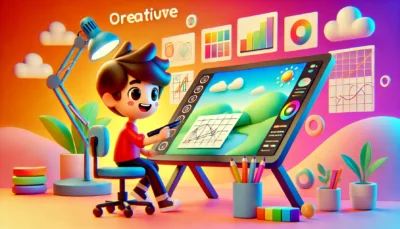Mastering Business Fundamentals for a Thriving Graphic Design Career
In the world of freelance graphic design, creativity alone isn’t enough to ensure success. To build a sustainable and profitable career, graphic designers must also develop essential business skills. This comprehensive guide will explore crucial aspects such as negotiation, client communication, and financial management. By mastering these skills, you can elevate your career and achieve long-term success.
Table of Contents
- The Importance of Business Skills in Graphic Design
- Why Business Acumen Matters
- Benefits of Developing Business Skills
- Effective Client Communication
- Building Strong Client Relationships
- Managing Client Expectations
- Mastering Negotiation Techniques
- Negotiating Project Terms
- Setting Value-Based Pricing
- Financial Management for Freelancers
- Budgeting and Expense Tracking
- Tax Planning and Preparation
- Enhancing Project Management Skills
- Streamlining Workflows
- Using Project Management Tools
- Portfolio Optimization for Business Growth
- Showcasing Your Best Work
- Highlighting Success Stories
- Leveraging Social Media Marketing
- Promoting Your Services Online
- Building an Engaged Audience
- Exploring Passive Income Opportunities
- Creating and Selling Digital Products
- Developing Online Courses and Tutorials
- Niche Specialization and Monetizing Design Skills
- Identifying Your Niche
- Marketing Your Expertise
- Conclusion: Elevating Your Graphic Design Business
1. The Importance of Business Skills in Graphic Design
1.1 Why Business Acumen Matters
While creativity is at the heart of graphic design, business acumen is essential for sustaining a successful career. Understanding the business side of graphic design helps you navigate client interactions, manage finances, and grow your brand. Without these skills, even the most talented designers can struggle to achieve long-term success.
1.2 Benefits of Developing Business Skills
Developing business skills offers numerous benefits, including increased profitability, better client relationships, and more efficient project management. By mastering these skills, you can position yourself as a professional, reliable designer who delivers high-quality work while effectively managing all aspects of your business.
2. Effective Client Communication
2.1 Building Strong Client Relationships
Effective communication is the foundation of strong client relationships. From the initial consultation to project delivery, clear and consistent communication ensures that both you and your client are on the same page. This fosters trust and collaboration, leading to successful projects and repeat business.
2.2 Managing Client Expectations
Managing client expectations is crucial for avoiding misunderstandings and ensuring satisfaction. Set clear expectations from the start, including project timelines, deliverables, and pricing. Regularly update clients on progress and address any concerns promptly. This proactive approach helps build long-term client relationships.
3. Mastering Negotiation Techniques
3.1 Negotiating Project Terms
Negotiation is a critical skill for securing favorable project terms. Learn to negotiate effectively by understanding your value and the client’s needs. Be prepared to discuss scope, deadlines, and compensation. Successful negotiation ensures that both parties are satisfied with the agreement, paving the way for a smooth project.
3.2 Setting Value-Based Pricing
Value-based pricing involves setting your rates based on the perceived value of your work to the client. This approach allows you to charge premium prices for high-quality work that delivers significant results. Clearly communicate the benefits and outcomes of your designs to justify your rates and attract clients willing to invest in quality.
4. Financial Management for Freelancers
4.1 Budgeting and Expense Tracking
Effective financial management is essential for maintaining profitability. Create a budget that accounts for all business expenses, including software, marketing, and professional development. Track your income and expenses meticulously to ensure that you stay within budget and identify areas for cost savings.
4.2 Tax Planning and Preparation
Tax planning is a crucial aspect of financial management for freelancers. Understand your tax obligations, including estimated taxes, deductions, and filing requirements. Consider working with a tax professional to ensure compliance and optimize your tax strategy. Proper tax planning helps you avoid surprises and keep more of your earnings.
5. Enhancing Project Management Skills
5.1 Streamlining Workflows
Efficient project management is key to delivering high-quality work on time. Streamline your workflows by breaking down projects into manageable tasks and setting clear deadlines. Prioritize tasks based on importance and deadlines to ensure that you stay on track and meet client expectations.
5.2 Using Project Management Tools
Project management tools like Trello, Asana, and Monday.com can help you organize tasks, track progress, and collaborate with clients. These tools provide a visual overview of your projects, making it easier to manage multiple assignments and stay organized. Utilizing project management tools enhances your efficiency and productivity.
6. Portfolio Optimization for Business Growth
6.1 Showcasing Your Best Work
A well-optimized portfolio is essential for attracting clients and showcasing your skills. Highlight your best work, including a variety of projects that demonstrate your versatility and expertise. Use high-quality visuals and detailed descriptions to provide context and highlight the impact of your designs.
6.2 Highlighting Success Stories
Include success stories and testimonials from satisfied clients in your portfolio. These provide social proof of your capabilities and help build trust with prospective clients. Highlight specific examples of how your work has contributed to your clients’ success to reinforce your value.
7. Leveraging Social Media Marketing
7.1 Promoting Your Services Online
Social media platforms like Instagram, LinkedIn, and Behance are powerful tools for promoting your graphic design services. Share your portfolio, behind-the-scenes content, and client testimonials to attract potential clients. Consistent and strategic social media marketing helps build your brand and expand your client base.
7.2 Building an Engaged Audience
Engage with your audience by responding to comments, participating in discussions, and sharing valuable content. Building an engaged community around your work fosters loyalty and trust, increasing the likelihood of referrals and repeat business. Social media marketing is an ongoing process that requires regular interaction and content updates.
8. Exploring Passive Income Opportunities
8.1 Creating and Selling Digital Products
Digital products, such as design templates and digital assets, offer a passive income stream. Create high-quality digital products that address common design needs and sell them on platforms like Etsy, Creative Market, and Gumroad. Passive income allows you to earn money without continuous effort, supplementing your primary income.
8.2 Developing Online Courses and Tutorials
Share your expertise by developing online courses and tutorials. These digital products allow you to reach a global audience and monetize your knowledge. Topics can range from beginner design tutorials to advanced techniques, catering to different skill levels. Promoting these products through social media marketing can further enhance your reach and income.
9. Niche Specialization and Monetizing Design Skills
9.1 Identifying Your Niche
Specializing in a specific niche can help you stand out from the competition and attract clients looking for expertise in that area. Identify your strengths and interests, and focus your efforts on becoming the go-to expert in your chosen niche. This specialization can lead to more significant opportunities and long-term partnerships.
9.2 Marketing Your Expertise
Once you have identified your niche, market your expertise through targeted social media content, blog posts, and case studies. Share your knowledge and insights related to your niche to establish yourself as an authority. Engaging with niche-specific communities can also help you reach your target audience.
Conclusion: Elevating Your Graphic Design Business
Mastering the business side of graphic design is essential for building a successful and sustainable freelance career. By developing skills in client communication, negotiation, financial management, project management, and marketing, you can elevate your business and achieve long-term success. Implement the strategies outlined in this guide to enhance your professional capabilities and thrive in the competitive world of freelance graphic design.





